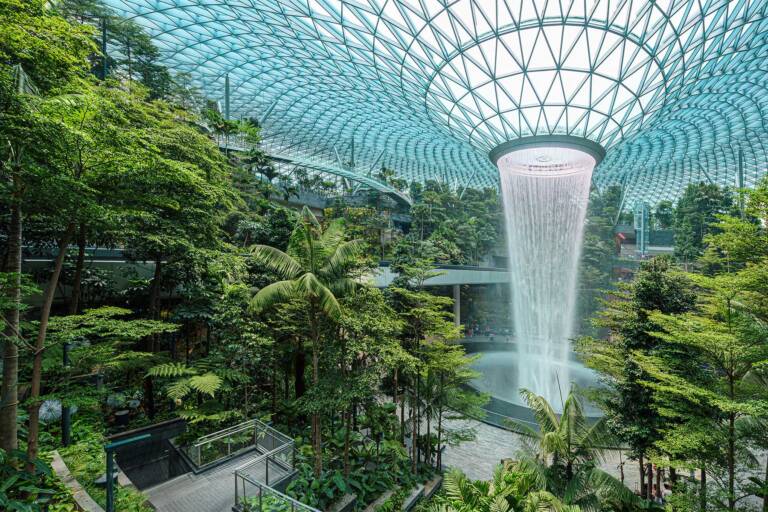Nature has always inspired architects and designers. Biophilic design brings this inspiration to life. It adds elements of nature to built environments.
Studies show being in nature boosts productivity and well-being. Biophilic design aims to bring these benefits to urban areas. It uses natural materials, patterns, and light in building design.
This design approach creates spaces that are pleasing to the eye. It also promotes occupant health.
Key takeaways
- Biophilic design incorporates natural elements into built environments.
- It aims to boost productivity and well-being by replicating nature’s benefits.
- Natural materials, patterns, and light are integral to biophilic design.
- This design approach promotes a poetic dialogue between nature and structure.
- Biophilic design creates spaces that are aesthetically pleasing and promote occupant health.
The Poetic Dialogue Between Nature and Structure
Biophilic design creates a poetic dialogue between nature and structure. It reflects our deep connection to the natural world. This design philosophy is more than just aesthetics; it’s a response to our environment.
The ancient roots of our connection to nature
Our ancestors lived in harmony with nature. They relied on it for survival. Modern architecture is revisiting this connection through biophilic design concepts. These include natural light, ventilation, and organic materials.
The modern renaissance of natural design
Today, architects are reconnecting us with nature in urban landscapes. Biophilic design in architecture is becoming more popular. It transforms buildings into ecosystems that promote well-being and sustainability.
This results in a harmonious blend of nature and structure. Buildings now coexist with their surroundings, becoming part of the natural landscape.
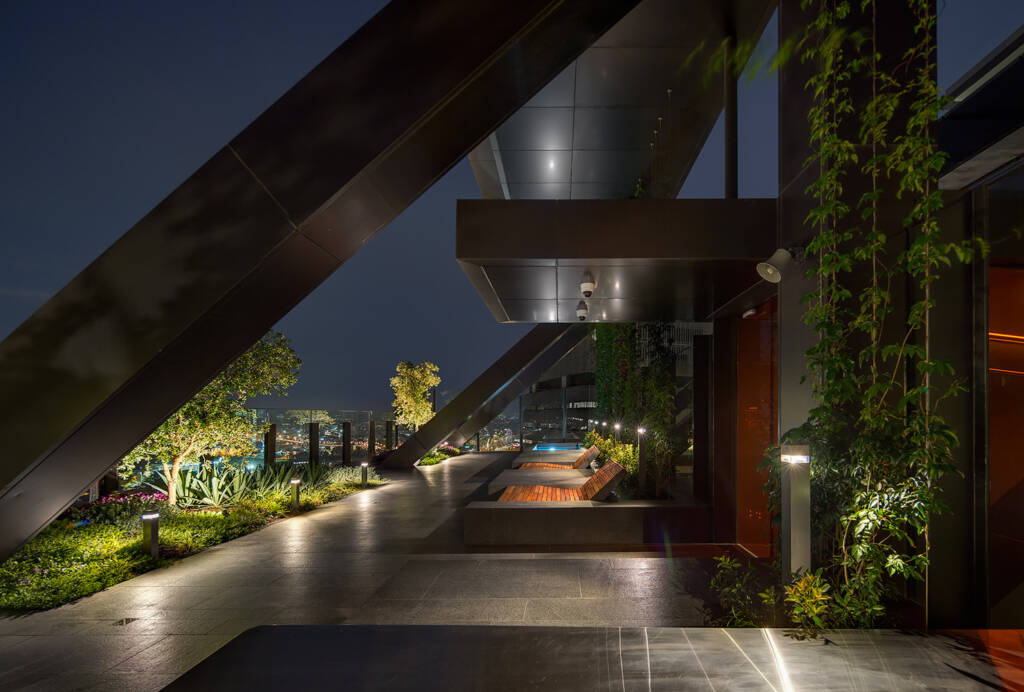
One Central Park
Image courtesy of FRASERS PROPERTY AUSTRALIA and SEKISUI HOUSE AUSTRALIA. Image © MURRAY FREDERICKS
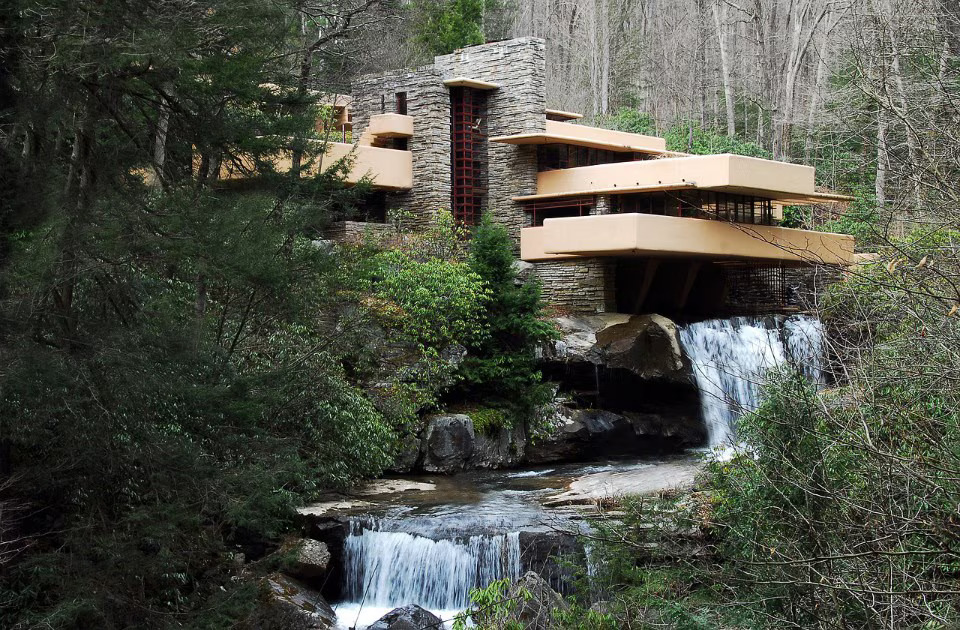
Courtesy of and WIKIMEDIA COMMONS and LACHRIMAE72
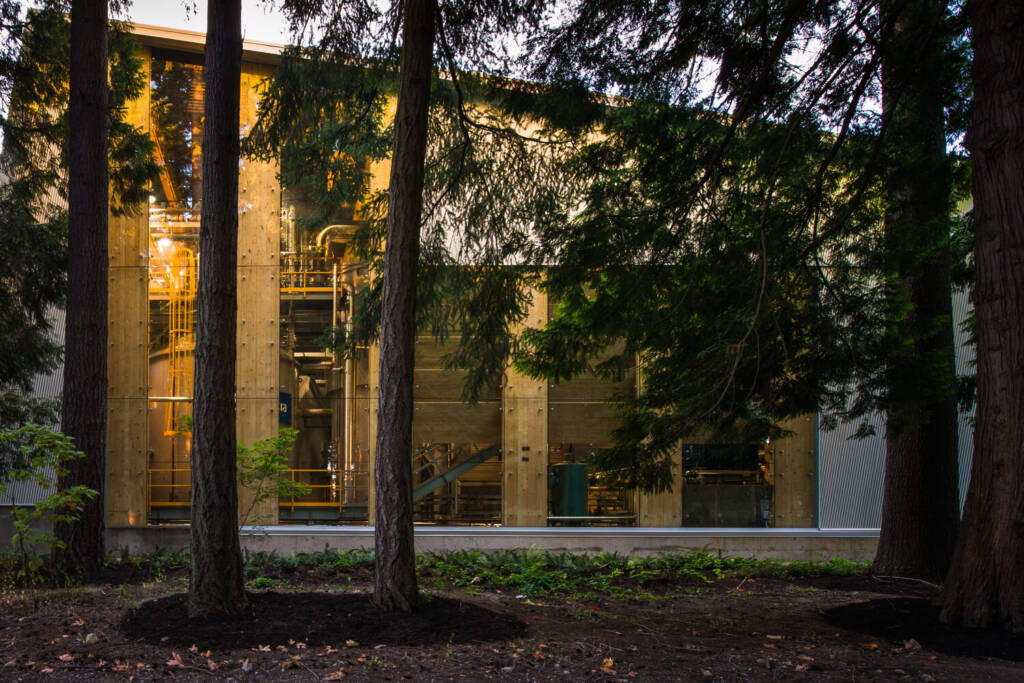
Bioenergy Research & Demonstration Facility, Vancouver
Image © DON ERHARDT, courtesy of NATURALLYWOOD.COM
What is Biophilic Design: The Symphony of Living Elements
Biophilic design is an innovative approach. It reconnects us with nature by adding elements of nature to our built environments. This design philosophy is based on the biophilia hypothesis, which says humans have an innate love for nature.
The Biophilia hypothesis: our innate affinity for nature
The biophilia hypothesis, introduced by biologist Edward Osborne Wilson, suggests our love for nature is biological. This innate love can be used in design to create spaces that boost well-being and productivity.
Defining the framework of nature-inspired design
Biophilic design is more than just adding plants. It includes natural light, ventilation, and materials. By using these elements, architects can create sustainable environments that support human health.
The evolution of biophilic principles in contemporary spaces
As cities grow, biophilic design becomes more important. Spaces that use biophilic principles improve occupant satisfaction, reduce stress, and enhance well-being. Key features include:
- Use of natural materials and textures
- Incorporation of natural light and ventilation
- Integration of plants and green spaces
In defining what is biophilic design, it’s clear it’s not just about looks. It’s about creating a balance between the built environment and nature. This enhances both human experience and environmental sustainability.
The Tapestry of Biophilic Design Concepts
Biophilic design combines natural elements to create spaces that support human well-being. This philosophy is based on our innate desire to connect with nature.
Direct experience: nature’s immediate presence
Direct experience means using nature in design. This can include:
- Maximizing natural light and ventilation
- Incorporating water features and plants
- Utilizing natural materials and textures
These elements help us feel nature’s presence. For example, big windows let in lots of light. Indoor plants also improve air and look.
Weather, Landscapes, and Fire Integration
Adding weather sensitivity and landscapes or fire features enhances nature’s feel. This makes spaces feel more connected to nature.
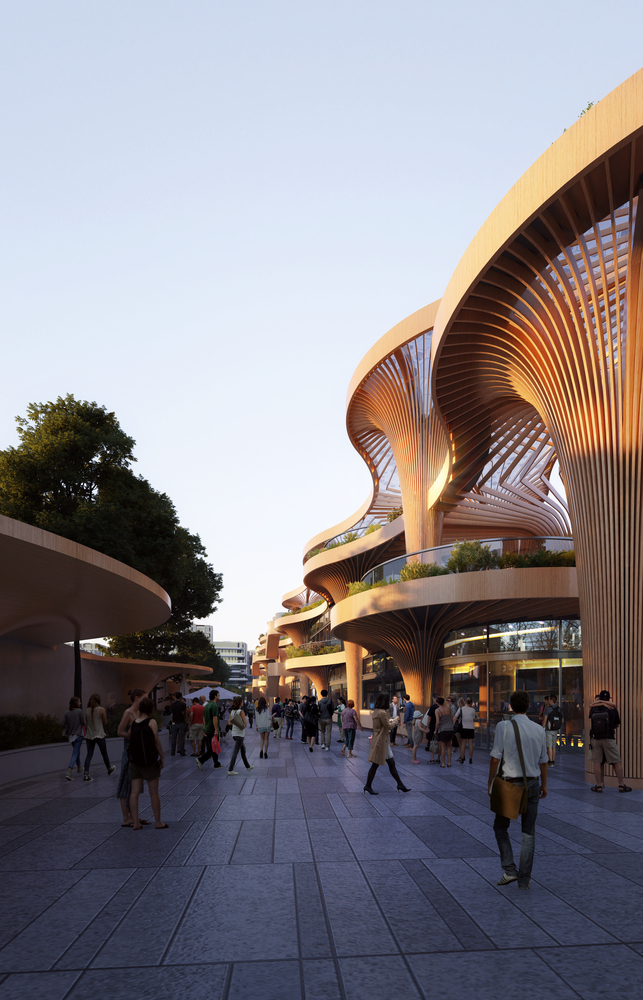
Solar Trees Marketplace
© DOUG AND WOLF

Solar Trees Marketplace
© DOUG AND WOLF
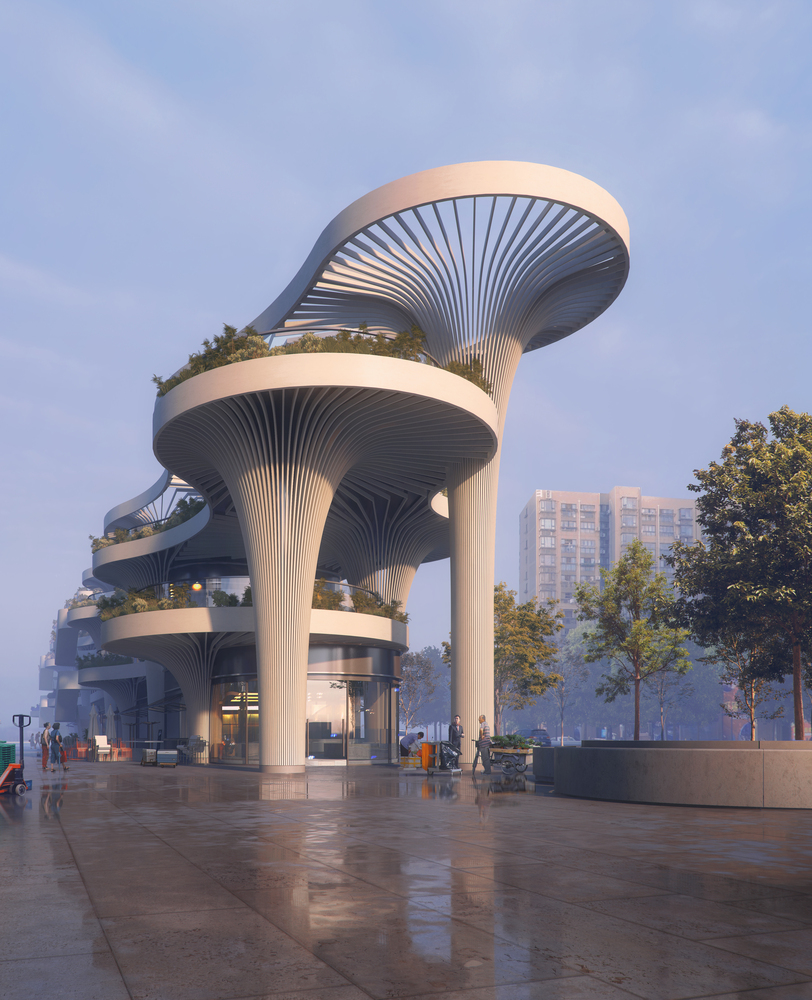
Solar Trees Marketplace
© DOUG AND WOLF
Indirect experience: nature’s echo
Indirect experience uses subtle nature references. This includes:
- Using natural materials, colors, and shapes
- Incorporating biomimicry and organic geometries
Natural Materials, Colors, and Shapes
Materials like wood and stone, and nature-inspired colors, create a natural feel. Shapes that look like nature add to this connection.
Biomimicry and Organic Geometries
Biomimicry draws from nature’s designs. Organic shapes add depth and beauty to designs.
Spatial experience: the poetry of place
The spatial experience makes a place feel special. This involves:
- Designing for prospect, refuge, and mystery
- Creating emotional attachments to spaces
Prospect, Refuge, and Mystery in Design
Designs should offer openness, safety, and intrigue. This engages people on a deeper level.
Creating Emotional Attachments to Spaces
Designs that meet human needs and include nature foster strong bonds. This connection between people and their environment is powerful.
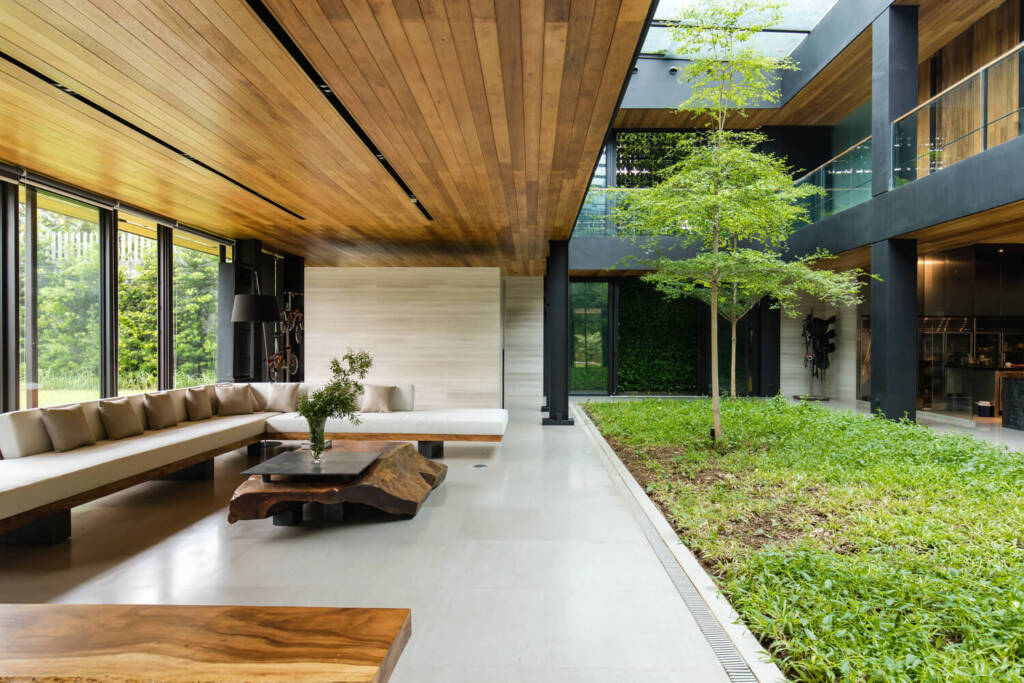
Courtesy of PXP DESIGN WORKSHOP CO
Eden Project Cornwall: A Cathedral to Nature’s Design
The Eden Project is a leader in biophilic design. It shows how nature and architecture can work together. This project blends the built world with nature seamlessly.
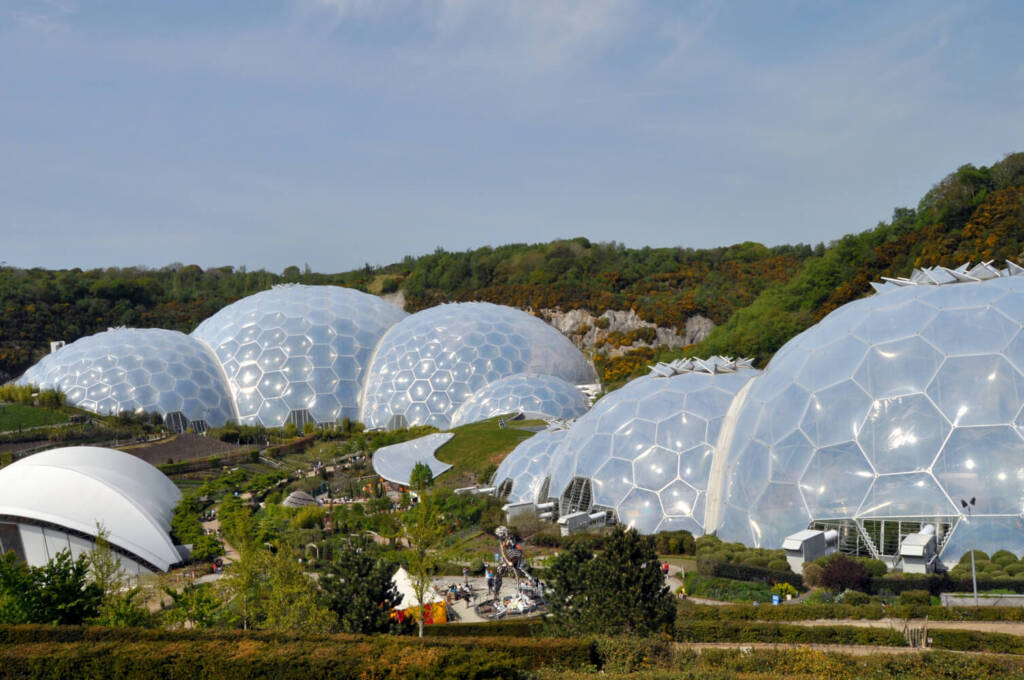
Image The Eden Project, Cornwall
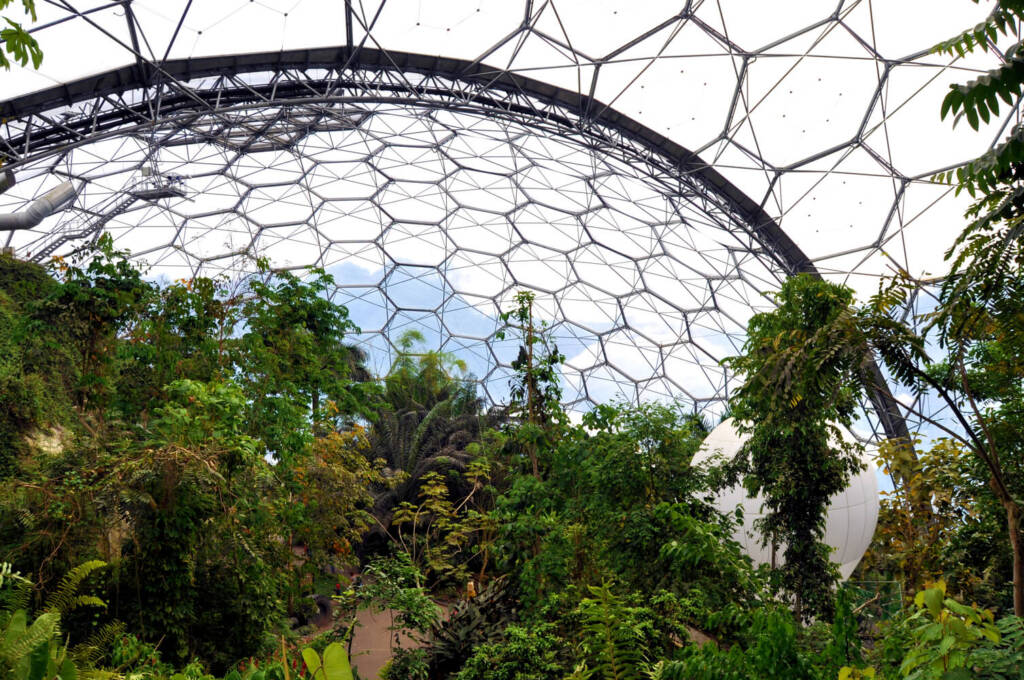
Image The Eden Project, Cornwall
Architectural vision and biophilic integration
The Eden Project focuses on biophilic design. It uses large biomes that mimic different climates and ecosystems. The design features curved, organic shapes that bring nature indoors.
- Innovative use of materials and structural engineering
- Integration of natural elements and ecosystems
- Creation of diverse, climate-specific environments
Visitor experience and environmental impact
The Eden Project offers a unique experience. It showcases a wide range of plants and ecosystems. It’s a model for eco-tourism and environmental stewardship.
- Promoting environmental awareness and education
- Fostering a connection between visitors and nature
- Showcasing sustainable practices and eco-friendly design
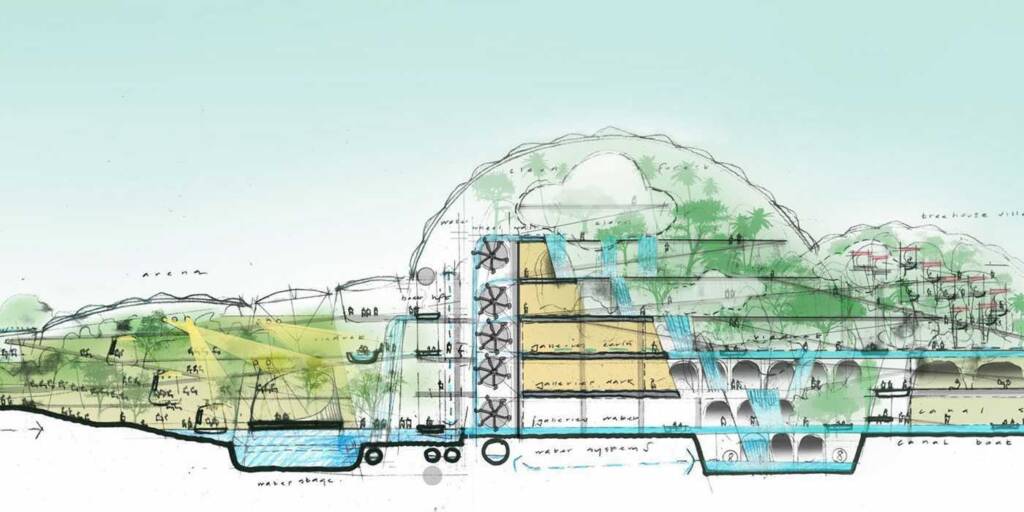
Image via EDEN PROJECT
The Healing Gardens: Biophilic Design in British Healthcare
Nature is being used in British healthcare through biophilic design. This makes patient care and staff wellbeing better. It brings natural elements into buildings, making them calm and peaceful.
Biophilic design concepts in healthcare are not just pretty. They are based on the biophilia hypothesis. This says humans naturally want to be near nature. By adding nature to healthcare places, they become healing spaces that help people get better.
Maggie’s Centres: case studies in therapeutic environments
Maggie’s Centres show biophilic design in action. These cancer care centers have natural light, materials, and landscapes. They show how biophilic design definition can make spaces that help and uplift people.
Quantifiable outcomes on patient recovery and staff wellbeing
Studies show biophilic design in healthcare improves patient outcomes. Patients recover faster and feel less stressed. Staff also feel better, with happier jobs and less burnout.
Urban Metamorphosis: Transforming London’s Commercial Spaces
Biophilic design is changing London’s commercial areas. It brings the outdoors into the city’s busy heart. This change is not just about looks; it’s a big shift in how we design and use commercial spaces.
London’s commercial areas are getting a new look with natural elements. This makes spaces better for people and looks great too.
The sky garden: elevated nature in the financial district
The Sky Garden is a great example of biophilic design in London’s financial area. It’s a lush, tropical place that offers a calm break from the city. It has panoramic views of the city and lots of plants.
Bloomberg’s European Headquarters: a breathing building
Bloomberg’s European Headquarters is another example of biophilic design. It has a living wall and an atrium that lets in natural light. This design makes the work environment better and sets a new standard for office buildings.
Measurable benefits for productivity and wellbeing
Studies show biophilic design has big benefits for productivity and wellbeing. By adding natural elements, these spaces improve air quality, reduce stress, and boost creativity.
- Enhanced productivity through natural light and ventilation
- Improved wellbeing through the presence of greenery
- Increased creativity inspired by natural elements

The Challenges and Triumphs of Implementing Living Design
Adding living design to buildings is a big challenge. It’s as rewarding as it is hard. Understanding biophilic design is key.
“Biophilic design is not just about looks; it’s about creating spaces that connect humans with nature,” experts say. This shows why we must consider both the good and the hard parts of using it.
Economic considerations and long-term value
One big challenge in using biophilic design is the cost. The benefits, like better productivity and wellbeing, are known. But the start-up costs can be high. It’s important to think about these costs and the long-term gains.
Using natural elements and materials can make a building last longer and be more sustainable. This can save money on upkeep over time. As biophilic design definition suggests, it’s about a good relationship between buildings and nature. This can lead to big economic gains.
Maintenance rhythms and sustainable practices
Biophilic design needs a good maintenance rhythm and sustainable practices. Buildings with living parts need careful planning. This ensures they look good and last long.
Using native plants can cut down on water and care needs. This makes the design more sustainable.
Architects and designers learn from the ups and downs of biophilic design. They create spaces that are not just pretty but also good for people and the planet.
Conclusion: The Continuing Journey Toward Harmony with Nature
Looking back, we see how biophilic design concepts change our world. From buildings to healthcare, it’s a big shift.
The Eden Project, Maggie’s Centres, and Bloomberg’s HQ show how biophilic design in architecture boosts well-being. It also connects us more with nature.
By using the biophilia hypothesis, we make spaces that are not just nice to look at. They also help people feel better and work better.
As we go on, we must keep exploring and using biophilic design. We want our buildings to be in tune with nature.
FAQ
What is biophilic design?
Biophilic design mixes nature into buildings and homes. It makes us feel better and connected to the outdoors.
What are the benefits of biophilic design?
It boosts mental health, makes us more productive, and creative. It also lowers stress and improves overall well-being.
How is biophilic design used in architecture?
In architecture, biophilic design adds natural elements like light, air, water, and plants. It aims to connect us to nature.
What are some examples of biophilic design concepts?
Biophilic design concepts include using plants and water directly. It also uses natural materials and colors to feel connected to nature.
How does biophilic design impact the environment?
Biophilic design helps the environment by encouraging green practices. It also cuts down on the need for artificial lights and heating.
What is the biophilia hypothesis?
The biophilia hypothesis says we naturally love nature. It’s key to our happiness and well-being.
How can biophilic design be incorporated into urban spaces?
In cities, biophilic design uses green roofs, walls, and natural elements. It also adds natural materials and colors to buildings.
What are some challenges associated with implementing biophilic design?
Challenges include cost, upkeep, and the need for green practices. These hurdles make it hard to use biophilic design.`
